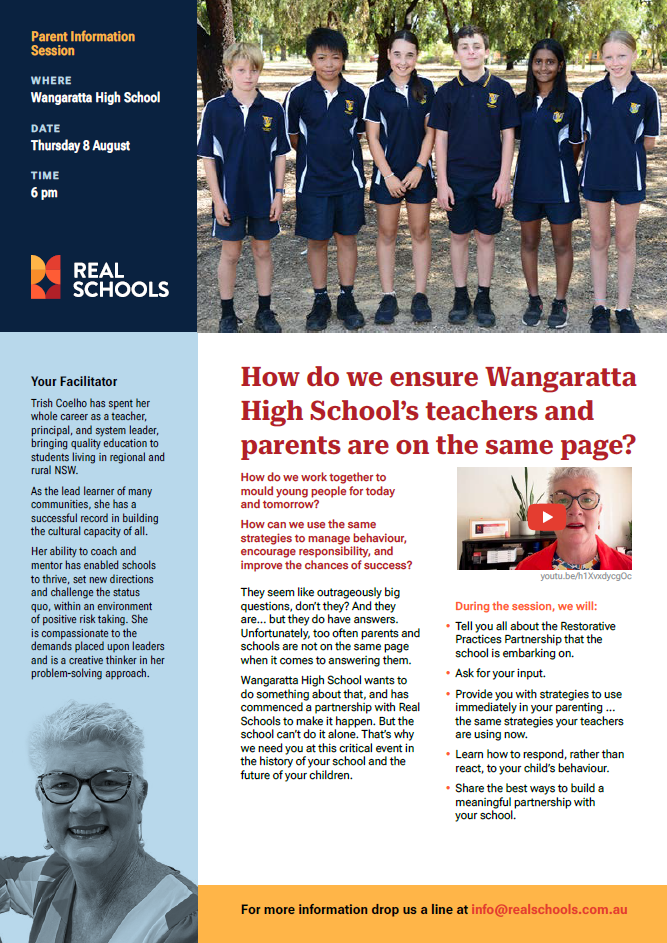Restorative Practice 2.0 at Wangaratta High School
At a full-day staff professional development day in Term 1 2024 , our entire staff participated in a full-day professional development day as we launched our three-year partnership with Real Schools to implement restorative practice. Restorative practices and adversarial methods represent distinct approaches to addressing conflicts, disputes and wrongdoing. The restorative approach is characterised by a holistic working method centred around building a robust relational culture. The approach strongly complements our existing approaches but will support further improvements. Exciting times!
Key Distinctions of Restorative Practices:
- Language: Restorative practice utilises open communication, affective language, and structured processes (e.g., circles or conferences) for sharing perspectives and emotions towards mutual solutions, contrasting with the formal legal language of adversarial methods.
- Conduct: Restorative practice promotes a resolution process where all parties have input, focusing on harm repair. Adversarial methods, in comparison, involve a formalised decision-making process, often leaving out those affected by the conflict.
- Mindset: Restorative practice centres on repairing harm and rebuilding relationships through empathy and understanding, encouraging collaborative issue resolution and accountability. Adversarial methods concentrate on guilt determination and punishment.
- Role of Authority: Restorative practices position the authoritative figure as a facilitator for open communication and mutual understanding, rather than as a disciplinarian or authoritarian imposing decisions.
One of the first changes we have made is to become more conscious about the language we use to create an environment where young people can grow and thrive, and I encourage parents and carers to consider the same. What the research on school culture (and that also applies to classroom culture) shows is that it’s the language we, as adults, use that is the most influential factor.
We began by slowly adjusting and experimenting with our language in four key ways. I thought that, if I shared them with you, then you might be able to help us with that, and that they will help you as parents/carers:
- Affective Language. We are increasingly use the language of affects/feelings when speaking to the students about the low-level behaviours that happen almost all the time in schools. Instead of saying “Hey, pick that up” if a student litters, you’ll now hear us saying “It disappoints me to see you do that. Please pick it up”. When students hear the word disappoint, they’re not only more likely to pick up the rubbish, but they also get valuable information about that kind of behaviour that leads to better self-regulation in the future.
The great part of Affective Language is that it can also be used positively to reinforce desirable behaviours by saying “I’m delighted to see you use the bin without being asked to”. You’d be surprised at how well it works. - Stored Responses. We’ve been talking about how our language can get off track sometimes – at home, at school and in the big wide world – when we get flustered or emotional. We’re working on storing scripted responses for those moments, so we don’t lose our cool or say the wrong thing.
- Positive Priming – this one’s quite easy. We are speaking more to behaviours we want to see rather than those we’d rather not see. It’s part of the reason that “don’ts don’t work” all that well when it comes to working with kids, particularly teenagers.
- Stakeholder Protection – we want a psychologically safe classroom for kids, staff and parents.
‘Don’ts don’t work’ all that well when it comes to working with kids, particularly teenagers.
In some ways, these changes seem small. Could they really change much? What we’re expecting (and seeing already) from the significant research and experience of others is that they really do. I think it’s got something to do with the enormous volume of opportunities we have to use these simple changes.
At home
I invite and encourage you to try any of these changes at home, too. Try walking into a messy bedroom, nodding knowingly and just saying “This mess is pretty frustrating” before calmly walking out. See what happens next!
I look forward to sharing more about our journey with restorative practice.
Dave Armstrong
Executive Principal
What is partnership?
Parent Resources
Our Expert Facilitator, Trish Coelho, spoke to parents and carers on the 8th of August 2024 about how she is supporting the implementation of Restorative Practice 2.0 at the High School, and how a restorative approach can support you as a parent/carer. The second parent/carer session will be in 2025.
We hope you find these resources helpful.

